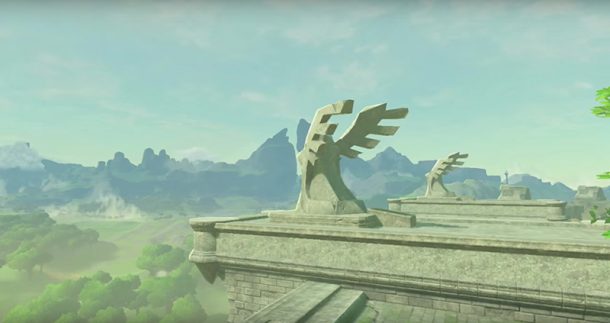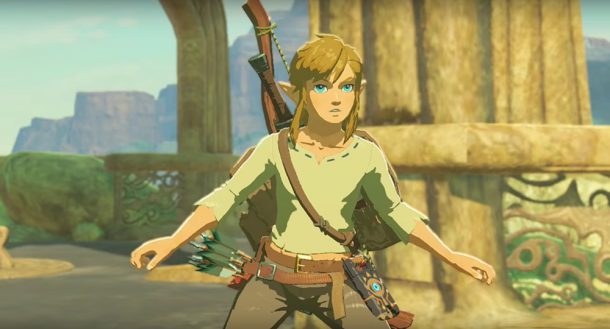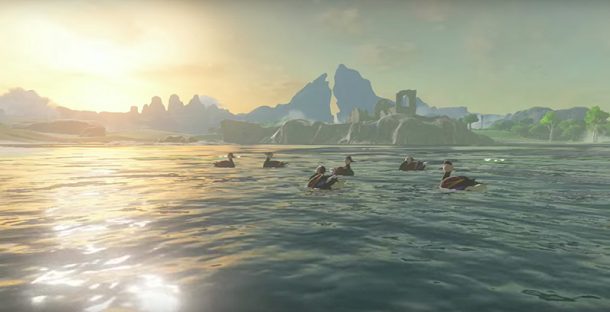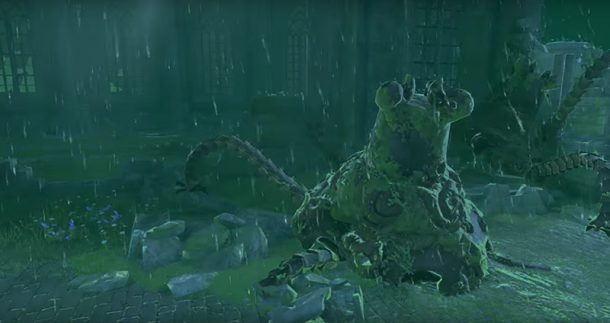True to its name, The Legend of Zelda: Breath of the Wild is full of openness and life. In a gameplay demo (played by Nintendo of America’s Bill Trinen) during their E3 presentation, the game’s Director Eiji Aonuma explained that the world is a living, breathing place that seems to be in ruin.

The live demo, beginning with Link waking up in the Shrine of Resurrection, seems to indicate that Link has done this before. As series fans will know, Link is a recurring character, born into different generations throughout Hyrule’s history to save the kingdom from evil. The Shrine seems to be where all of this takes place, at least from the early moments. The disembodied female voice tells us that Link is meant to bring light to the world, and that can only begin if he leaves his resting place.
As link exits the Shrine with his trusty Sheikah Slate, he enters a massive open world, beginning with the Great Plateau upon which he can oversee all of Hyrule. A short jog and Link bumps into a campfire and an old man — which Aonuma revealed may have some tie to the original Legend of Zelda game — to discover that the Great Plateau is the birthplace of the Kingdom of Hyrule, and that kingdom is now in ruin.

Before we get too far, it’s worth noting that all of this is revealed in text, as Link doesn’t speak and the old man only replies in words and not voice. The voice acting we *do* come across only appears in the Shrine as Link awakens.
Link can run around the world, pick up items (like sticks) to use as weapons or mushrooms and apples to eat. Hearts will no longer appear in the world to replenish health, Aonuma revealed; instead Link will use the resources of his environment to survive. That includes starting fires as needed, cooking, pushing rocks onto enemies, swimming, and even climbing and jumping. Yes, Link can finally jump, something that fans have been asking for since A Link to the Past.

This level of realism is a departure from past Zeldas, and yet it seems to tie us all the way back to the origins of the series. Aonuma further let out that Zelda is about adventure and survival and exploration, so going back to those roots (and scaling back on some of the more stalwart elements of the series) could provide a refresh for the game.
Another aspect of the game that will make for a departure is the necessity to change weapons and armor often. Link’s weapons can become damaged and break over time, and so he needs to carry a bounty of them for when they do. A rusty sword may be great for a few battles but will eventually break. And a stick might light a few things on fire, but that same stick becomes worthless when it chars away. The same can be said about clothing, as Link now has the option to gain defensive and offensive statistical enhancements based on what he’s wearing and using. During the demo, we see stat numbers next to items, giving a sort of RPG-lite feel to how Link interacts with his world.
Link’s fighting skills seem to have improved over time as well, as he awakens with almost the skillset of a warrior. The slowdown of time that we’ve seen in past teasers is explained here, as timing an attack perfectly will allow Link to capitalize on damage, and unleash a flurry of hits as needed.

But really, this game is about the world and Link waking up in it. The painterly art style, chosen to be similar to the Wii’s Skyward Sword, allows the player to focus on animations to differentiate items and enemies from the environment.
Even the title of the game, Breath of the Wild, is purposefully themed. In the past Zelda’s titles have focused on characters or items. By focusing on the world, the latest Legend should shift the focus back on exploration and adventure, and make for a more surprising journey for the hero.
We’ll have more on Zelda after our time with the game this week at E3. Until then, watch the trailer.

![[E3 2016] The Legend of Zelda: Breath of the Wild is open world and alive](https://www.sidequesting.com/wp-content/uploads/zelda_breath_of_the_wild-01.jpg)
No Comments